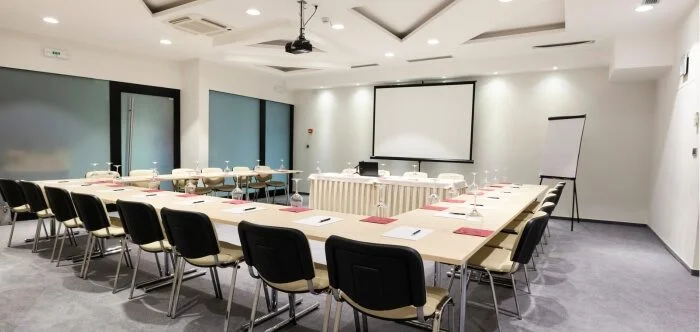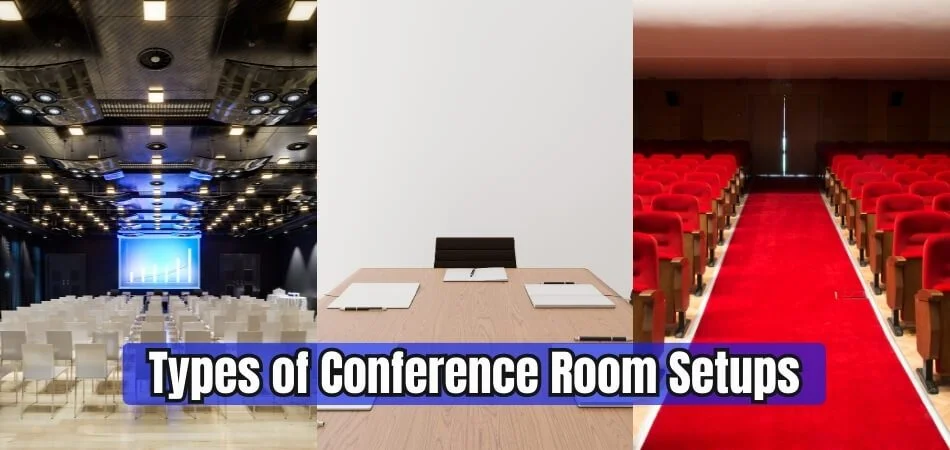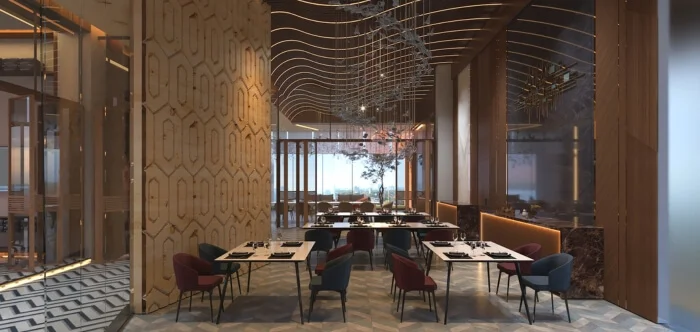In today’s fast-paced business world, the design of a conference room can significantly influence the success of any meeting or event. Understanding the various types of conference room setups is crucial for ensuring that your meetings are both productive and engaging.
From the classic boardroom style, perfect for in-depth discussions, to the U-shape arrangement ideal for presentations, each layout caters to specific needs.
Additionally, the classroom setup is tailored for lectures, the theater style suits seminars, the hollow square fosters group talks, the banquet setup combines meals and discussions, the cabaret style enhances workshops, and the circle arrangement encourages open discussions.
This article delves into these diverse configurations, offering insights on how to choose the right one for your next meeting. Stay tuned to uncover how these setups can transform your conference experiences.
What is a Conference Room?- General Overview
A conference room is a designated space within an organization where members gather for meetings, discussions, and collaborative tasks. These rooms are essential for fostering communication and decision-making processes within teams. Equipped with various technologies, they enable efficient and productive interactions.

The primary function of a conference room is to provide a private and focused environment for group meetings. It often includes features like a large table, comfortable seating, and presentation equipment. Collectively, these elements contribute to an effective and conducive meeting atmosphere.
Essentials for a Conference Room
Creating a functional and effective conference room requires careful consideration of several key components. These elements not only enhance the usability of the space but also contribute to the productivity of meetings. Understanding what makes a conference room efficient is vital for any organization.
Adequate Seating and Table
Comfortable seating is crucial for lengthy discussions and meetings. The table should be large enough to accommodate all participants comfortably. Ergonomic chairs add to the comfort, ensuring attendees remain focused and engaged. The right furniture combination can significantly boost the effectiveness of meetings.
Advanced Technology and Equipment
Essential technological equipment includes a high-quality projector, screen, and reliable internet connection. Additionally, teleconferencing facilities are vital for connecting with remote participants. Investing in good sound systems and microphones ensures clear communication. These technological essentials are indispensable for modern business interactions.
Effective Lighting and Acoustics
Good lighting is essential for maintaining alertness and minimizing eye strain. Natural light is preferable, but artificial lighting should be bright and non-intrusive. Soundproofing and acoustics play a vital role in maintaining concentration and privacy. Proper acoustical design prevents external noise interference and echo within the room.
Accessible Power Outlets and Connectivity
Easy access to power outlets is critical for charging laptops and other devices. If possible, the room should have ample charging points, including USB ports. Strong and stable Wi-Fi connectivity is a must for seamless digital collaboration. These facilities ensure uninterrupted productivity during meetings.
Equipping a conference room with the right furniture, technology, and facilities facilitates effective meetings. By prioritizing these essentials, organizations can ensure their conference spaces are conducive to productive and efficient discussions.
Types of Conference Room Setups
Conference rooms are more than just meeting spaces; they are dynamic environments that adapt to various interaction needs. The setup of a conference room plays a crucial role in facilitating effective communication and collaboration. Understanding the different types of conference room setups can greatly enhance the productivity of meetings.
Boardroom Style
Ideal for executive meetings and decision-making sessions, the boardroom style features a large central table. Participants are seated around the table, fostering an environment of equality and open discussion. This setup is best suited for smaller groups where interaction and direct communication are key.
The boardroom style’s intimate setting promotes collaboration and is conducive to in-depth discussions. It allows easy engagement among all participants, making it perfect for high-level meetings. The close proximity also facilitates confidential conversations and focused dialogues.
U-Shape
The U-shape setup is characterized by tables arranged in an open-ended configuration. This layout is optimal for presentations, workshops, and training sessions, allowing clear visibility for each participant. The open end of the ‘U’ faces the presentation area, making it ideal for speaker-led sessions.
In this setup, the speaker or facilitator can easily move around and engage with participants. It also allows attendees to have clear sightlines to the presentation area and each other. This arrangement supports interactive discussions and active participation from all attendees.
Classroom Style
Mimicking a traditional classroom, this setup includes rows of tables facing the front of the room. It’s suitable for lectures, seminars, or any event where the focus is on the presenter. The classroom style maximizes space utilization, accommodating a larger audience.
Each participant has their own space, conducive to taking notes and using personal devices. This format is less interactive but highly efficient for disseminating information. It’s ideal for instructional or informational sessions where audience interaction is minimal.
Theater Style
This setup involves rows of chairs facing the front, without tables, maximizing seating capacity. It’s perfect for large seminars, product launches, or briefings where interaction is not the primary focus. The theater style offers an efficient way to accommodate a large audience.
The layout focuses on the speaker or presentation, minimizing distractions. While interaction is limited, it’s excellent for events emphasizing information delivery over discussion. This setup is also easy to assemble and dismantle, making it practical for single-use events.
Hollow Square Style
The hollow square setup consists of four tables arranged in a square or rectangle. This configuration is great for committee meetings, group discussions, and team briefings. It allows each participant to face each other, promoting equal participation.
This layout is conducive to open dialogue and collaboration among attendees. It supports a democratic atmosphere where everyone is seen and heard. The hollow center can also be used for displaying prototypes or documents.
Banquet Style
Often used for meals and informal gatherings, the banquet style includes round tables. Each table typically seats 8-10 people, encouraging small-group discussions and networking. This setup is perfect for award ceremonies, gala dinners, or corporate luncheons.
The arrangement allows for a mix of eating, socializing, and business discussions. It provides a relaxed and comfortable atmosphere, ideal for dining and interaction events. This setup also facilitates networking opportunities among attendees.
Cabaret Style
Similar to a banquet but with an open end facing the stage or presentation area. This setup is perfect for workshops and collaborative events where interaction with a presenter is needed. It combines the benefits of round table discussions with focused attention on presentations.
The cabaret style encourages group interaction while maintaining focus on the speaker or central presentation. It’s ideal for interactive sessions that combine presentations with group activities. This layout fosters a dynamic and engaging atmosphere.
Circle Style
The circle setup involves chairs arranged in a circle or oval, without tables. This layout is excellent for open discussions, brainstorming sessions, and team-building activities. It removes any hierarchy, promoting equality and openness among participants.
In this setup, every participant faces each other, facilitating direct eye contact and engagement. It’s ideal for activities requiring a high interaction and participation level. The circle arrangement fosters an environment of inclusivity and collaboration.
In summary, selecting the right conference room setup is crucial for the success of any meeting or event. Each type of setup is designed to facilitate different interactions and activities. By choosing the most appropriate layout, organizers can significantly enhance the effectiveness and productivity of their events.
How to Choose the Right Setup for the Conference Room?
Choosing the right setup for a conference room is pivotal in ensuring the success of any meeting or event. The layout can significantly influence the effectiveness of communication and the overall experience of participants. Here, this guide provides a step-by-step approach to selecting the most appropriate conference room setup for your needs.
Step-1. Assess the Meeting’s Purpose
Start by understanding the primary objective of your meeting. Is it a brainstorming session, a formal presentation, or a training seminar? Different objectives require different setups to facilitate the intended interaction and engagement levels.
Step-2. Consider the Number of Participants
The number of attendees plays a crucial role in determining the setup. Larger groups may require arrangements like theater or classroom styles, while smaller groups can benefit from a boardroom or U-shape setup.
Step-3. Evaluate the Need for Technology
Determine the technological requirements of your meeting. Will you need projectors, teleconferencing facilities, or internet access? Ensure the chosen setup can accommodate these needs without hindering visibility or communication.
Step-4. Factor in Interaction Levels
Decide how much interaction will be involved. Consider circular, U-shape, or hollow square setups for highly interactive meetings. For more presentation-focused events, theater or classroom styles might be more suitable.
Step-5. Space and Comfort Considerations
Ensure the chosen setup is feasible within the available space. There should be enough room for comfortable movement and seating. Also, consider the comfort of the participants, especially for longer meetings.
Selecting the right conference room setup is a multifaceted decision that depends on the meeting’s purpose, number of participants, technological needs, desired interaction levels, and the physical space available. By carefully considering these factors, you can create an environment conducive to productive and successful meetings.
Considerations While Choosing a Setup for the Conference Room
A critical aspect of meeting planning is selecting the appropriate setup for a conference room. It influences the effectiveness of communication, the level of participant engagement, and the event’s overall success. This list highlights key considerations to keep in mind while choosing a conference room setup. Here they are:
- Meeting Objective: Understand the primary goal of your meeting; different aims require different layouts for optimal effectiveness.
- Participant Number: Assess the number of attendees to ensure the space accommodates everyone comfortably without feeling crowded.
- Technology Requirements: Consider the technological needs, such as audio-visual equipment, to ensure seamless integration into the chosen setup.
- Interaction Level: Choose a layout that facilitates the desired participant interaction and engagement level during the meeting.
- Space Availability: Evaluate the available space to determine feasible setups, ensuring enough room for movement and interaction.
- Furniture and Comfort: Ensure the furniture is suitable for the meeting’s duration, prioritizing comfort to maintain attendee focus and engagement.
- Acoustics and Lighting: Good acoustics and lighting are essential for maintaining attention and ensuring clear communication during the meeting.
- Flexibility and Adaptability: Select a setup that can easily be adjusted or modified to suit changing needs or unexpected scenarios.
When choosing a setup for a conference room, it’s essential to consider the meeting’s objective, the number of participants, technological requirements, desired interaction level, space availability, furniture comfort, acoustics, lighting, and the flexibility of the setup. These considerations help ensure that the chosen arrangement meets the needs of the meeting and contributes to its overall success.
Tips to Avoid Any Mistakes While Setting up the Conference Room
Setting up a conference room is key to the success of any meeting or event. It’s important to pay attention to detail and anticipate the needs of participants. Avoiding common mistakes can greatly enhance the experience and productivity of your meeting. Here are a few tips to help you do just that:
- Double-Check Technology: Always test audio-visual equipment and internet connectivity before the meeting to avoid technical glitches.
- Plan Seating Arrangement: Arrange seating based on the meeting’s purpose and expected level of interaction among participants.
- Ensure Comfort: Provide comfortable seating and adequate space for each participant, especially for longer meetings.
- Optimize Lighting: Make sure the room is well-lit, preferably with natural light, to keep attendees alert and focused.
- Manage Acoustics: Check the room’s acoustics to ensure there are no issues with sound echoing or external noise interference.
- Accessible Power Outlets: Ensure there are enough power outlets accessible to participants for charging laptops and other devices.
- Prepare for Flexibility: Be prepared to adjust the room setup if the number of participants or meeting requirements change.
- Clear Signage: Provide clear signage for the conference room, especially if it’s located in a large or complex venue.
Paying attention to these details when setting up a conference room can prevent common mistakes. Ensuring the right technology, seating arrangement, comfort, lighting, acoustics, power access, flexibility, and clear signage are all critical factors that contribute to a successful and productive meeting.
Wrap Up
The effectiveness of any meeting or event is significantly influenced by the chosen types of conference room setups. These configurations, ranging from boardroom to circle styles, cater to various meeting objectives and participant interactions.
Key factors such as the meeting’s purpose, participant number, technological needs, and the room’s comfort, lighting, and acoustics must be considered to ensure the chosen setup aligns with the event’s goals. Additionally, meticulous preparation, including double-checking technology and planning seating arrangements, is essential to avoid common setup mistakes.
Errors in these areas can lead to reduced productivity and engagement, underscoring the importance of precision in conference room preparation. Ultimately, the right setup, combined with attention to detail, can transform any meeting into a productive, engaging, and successful endeavor.
Errors in these areas can lead to reduced productivity and engagement, underscoring the importance of precision in conference room preparation. Ultimately, the right setup, combined with attention to detail, can transform any meeting into a productive, engaging, and successful endeavor.







